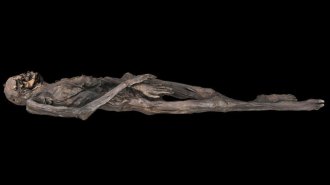Stone Age folk in Asia adapted to extremes
The Chang Tang Nature Reserve, situated 12,000 feet above sea level in the northwestern part of China’s Tibetan Plateau, features bitter cold, sparse vegetation, cutting winds, and little water. Scientists have now obtained preliminary evidence that people nonetheless colonized this forbidding territory near the end of the Stone Age.

The discovery of stone tools and spear points, as well as the remains of temporary camps dated to between 12,000 and 11,000 years ago, indicates that late-Stone Age groups adapted to some of the planet’s harshest environments, says archaeologist P. Jeffrey Brantingham of the Santa Fe (N.M.) Institute.
“We’ve probably underestimated the diversity of hunter-gatherer adaptations to extreme environments during the late Stone Age,” Brantingham remarks. He and his colleagues, John W. Olsen of the University of Arizona in Tucson and George B. Schaller of the Wildlife Conservation Society in New York City, describe their new findings in the June Antiquity.
Ecological field surveys, which Schaller directed in the mid-1990s in the Chang Tang Reserve, yielded nearly 400 stone artifacts. Surveyors found the implements lying on the ground at 18 widely separated locations, most in the reserve’s eastern section.
The finds include a variety of sharpened blades and spear points, ranging from about three-fourths of an inch to 3 inches long. Investigators also found round stones from which blades and other implements had been pounded off. The Chang Tang blades bear signs of extensive resharpening and were apparently recycled for different types of jobs, the researchers say.
Brantingham and Olsen conducted initial excavations at several Chang Tang sites last summer. Radiocarbon dates for human occupation come from charcoal found in hearths at these locations.
When the two scientists return to the sites in September, they’ll probe for clues about the late Stone Age’s climate and environment. Some researchers, suspecting the area was covered by an ice sheet during the late Stone Age, have doubted that people could have settled there then.
Brantingham proposes, however, that hunter-gatherers lived in this region by successfully contending with severe cold and scant water supplies. The size and shapes of their stone blades and spear points suggest that they hunted available game, such as antelopes and yak, he says.
“I believe that the Tibetan Plateau had a late [Stone Age] human occupation, as the new data suggest,” says archaeologist Mark Aldenderfer of the University of California, Santa Barbara. He asserts that researchers should find sites on the plateau with multiple layers showing occupations over time. Aldenderfer is currently traveling to the Tibetan Plateau in an attempt to do just that.







